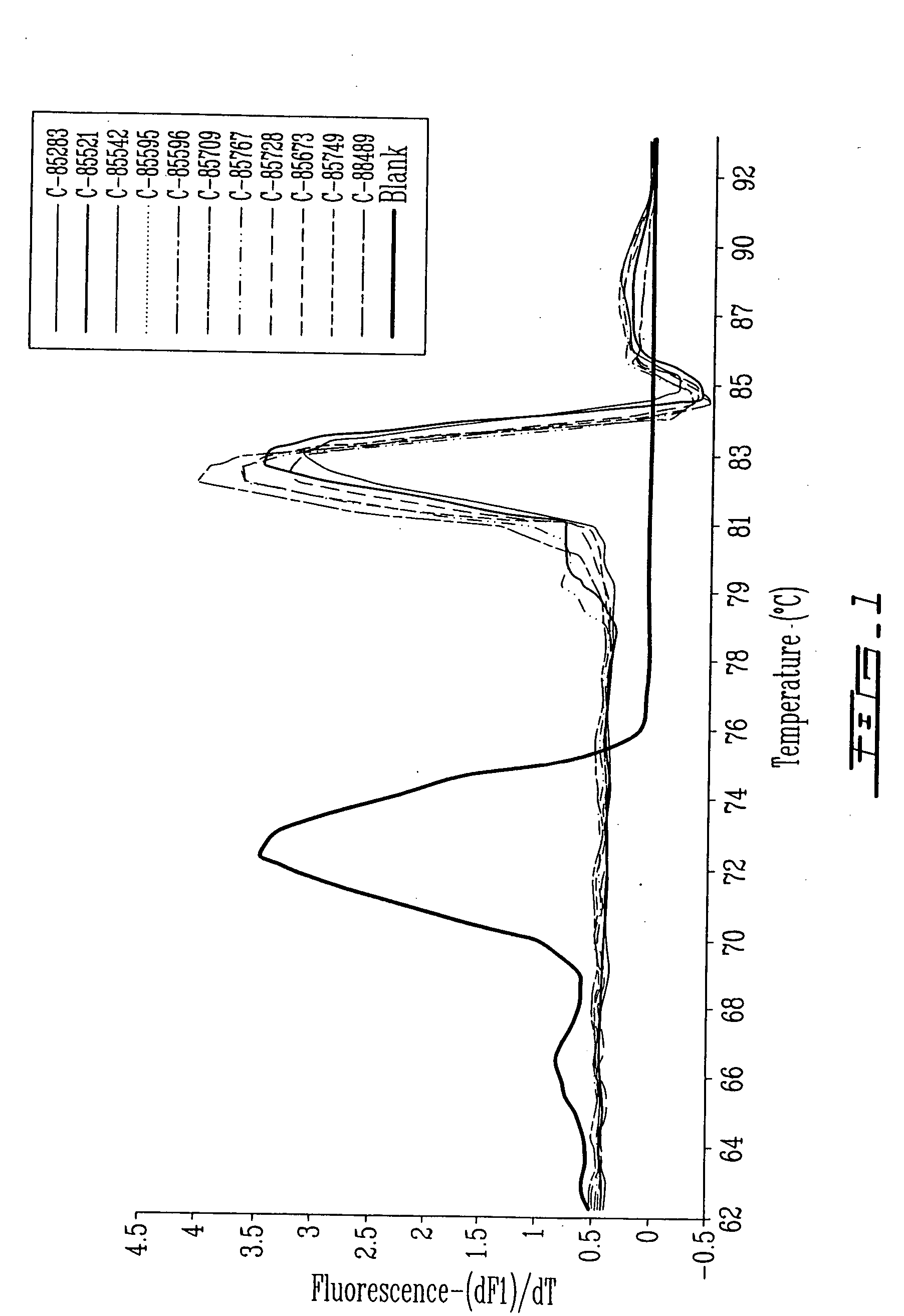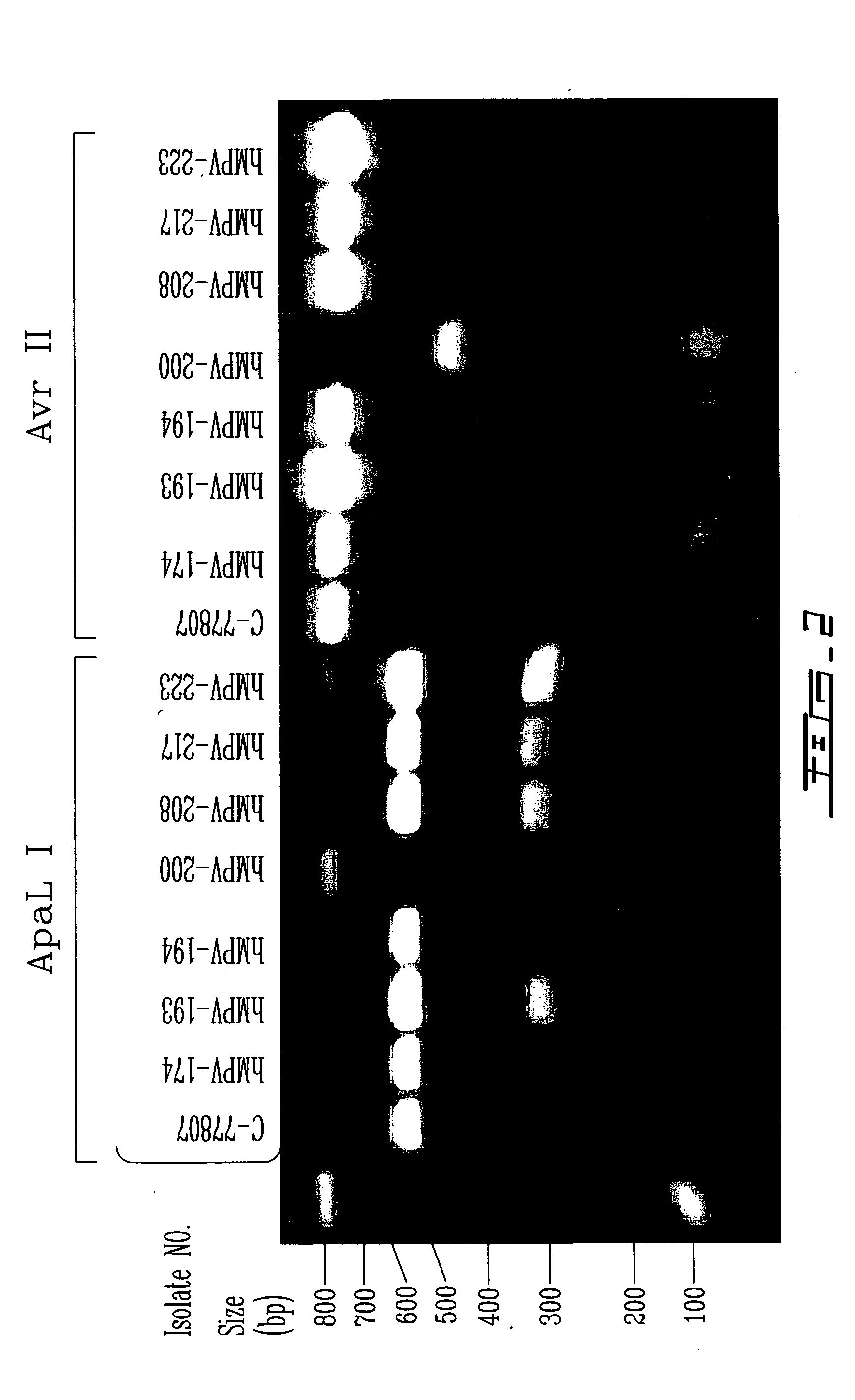Molecular methods and compositions for detecting and quantifying respiratory viruses
a respiratory tract virus and molecular composition technology, applied in the field of respiratory tract virus detection, can solve the problems of paramyxoviruses being initially negative, virus growth in vero and a549 cells was poor, and the virus could not be propagated, so as to achieve rapid and sensitive effects
- Summary
- Abstract
- Description
- Claims
- Application Information
AI Technical Summary
Benefits of technology
Problems solved by technology
Method used
Image
Examples
example i
Evaluation of Different Primers for hMPV Detection
[0086] An evaluation of the sensitivity of different hMPV primer sets in a real-time PCR assay was performed using 20 positive hMPV cultures grown in LLC-MK2 cells and 10 naso-pharyngeal aspirate specimens. These samples were collected in the Quebec City area (QC, Canada) over a period of 3 years (2000-2002). Viral RNA was prealably extracted from 200 μl of viral culture supernatants or naso-pharyngeal aspirates using the QIAamp Viral RNA Mini Kit (QIAGEN). Complementary DNA was synthesized using 10 μl of eluted RNA, 0.75 μM of a specific hMPV primer (Table 2, sequences ID Nos. 91, 97, 100, 102, 112), and the Omniscript Reverse Transcriptase Kit (QIAGEN, Mississauga, ON, Canada) following the manufacturer's recommendations. Complementary DNA was amplified using a real-time PCR procedure with the LC Faststart DNA Master SYBR Green 1 Kit (Roche Diagnostics, Laval, QC, Canada) in a LightCycler instrument (Roche Diagnostics). Each react...
example ii
Validation of a Real-Time PCR Assay for the hMPV Nucleoprotein (N) Gene in a Pediatric Population
[0088] An hMPV N plasmid was constructed by subcloning the amplified hMPV N region in the plasmid pDrive (QIAGEN, Mississauga, ON, Canada). The new plasmid was transcribed using the RNA Transcription Kit (Stratagene, Vancouver, BC, Canada) for sensitivity analysis. Using the previously described RT procedure (N primer, sequence ID No. 91) and real-time PCR protocol (N primers, sequence ID Nos. 92 and 94) reported in example 1, the sensitivity of the assay was estimated at 100 copies per reaction with a specific melting temperature of 82° C. The assay was found to be specific with no amplification signal observed when viral cultures positive for the human respiratory syncytial virus, the parainfluenza viruses, the influenza viruses A and B, and the adenoviruses were tested. The real-time PCR assay for the hMPV N gene was subsequently validated in a prospective case-control study in child...
example iii
Typing of hMPV Clinical Strains Using Restriction Enzyme Analysis
[0090] A rapid molecular typing method has been designed for hMPV epidemiological studies based on amplification of a portion of the fusion (F) gene which is then digested with specific restriction enzymes. Briefly, a 759-bp fragment of the hMPV F gene was amplified by a real-time PCR procedure as described in example 1 using specific primers (sequence ID Nos. 97 and 98). After PCR amplification, two aliquots (10 uL) of the PCR product were digested during 2 hours at 37° C. with 10 units of ApaL 1 and 4 units of Avr II (New England Biolabs, Mississauga, ON, Canada) according to the manufacturer's recommendations. Digested products were then loaded on an 1% agarose gel for electrophoresis.
[0091] Table 6 summarizes the size of the F fragments obtained for different hMPV isolates following enzymatic digestion and the corresponding genotype as defined by DNA sequencing and phylogenetic studies. In brief, all hMPV isolate...
PUM
| Property | Measurement | Unit |
|---|---|---|
| Temperature | aaaaa | aaaaa |
| Temperature | aaaaa | aaaaa |
| Temperature | aaaaa | aaaaa |
Abstract
Description
Claims
Application Information
 Login to View More
Login to View More - R&D
- Intellectual Property
- Life Sciences
- Materials
- Tech Scout
- Unparalleled Data Quality
- Higher Quality Content
- 60% Fewer Hallucinations
Browse by: Latest US Patents, China's latest patents, Technical Efficacy Thesaurus, Application Domain, Technology Topic, Popular Technical Reports.
© 2025 PatSnap. All rights reserved.Legal|Privacy policy|Modern Slavery Act Transparency Statement|Sitemap|About US| Contact US: help@patsnap.com



